New AMD Ryzen 3000XT Processors Available Today
by Dr. Ian Cutress on July 7, 2020 9:01 AM EST
Announced a couple of weeks ago, the new AMD Ryzen 3000XT models with increased clock frequencies should be available today in primary markets. These new processors offer slightly higher performance than their similarly named 3000X counterparts for the same price, with AMD claiming to be taking advantage of a minor update in process node technology in order to achieve slightly better clock frequencies.
The new 3000XT family of processors focuses mostly on boosting the turbo frequency by 100-200 MHz for the same power. AMD states that this is due to using an optimized 7nm manufacturing process. This is likely due to a minor BKM or PDK update that allows TSMC/AMD to tune the process for a better voltage/frequency curve and bin a single CPU slightly higher.
An update in this range could be indicative of a ~10 mV better voltage for a single core, although this would normally be in the binning noise - for it to be statistically relevant would need a lot of CPUs, so this could just be better binning. However, base frequencies haven’t moved much, so performance-per-watt benefits are going to be somewhat minimal. The biggest uptick would be in 1T scenarios.
Each of the new XT processors is the highest speed variant of its respective class.
| AMD 'Matisse' Ryzen 3000 Series CPUs | |||||||||
| AnandTech | Cores Threads |
Base Freq |
Boost Freq |
L3 Cache |
PCIe 4.0 |
TDP | Price (SEP) |
||
| Ryzen 9 | 3950X | 16C | 32T | 3.5 | 4.7 | 4x16 MB | 16+4+4 | 105W | $749 |
| Ryzen 9 | 3900XT | 12C | 24T | 3.8 | 4.7 | 4x16 MB | 16+4+4 | 105W | $499 |
| Ryzen 9 | 3900X | 12C | 24T | 3.8 | 4.6 | 4x16 MB | 16+4+4 | 105W | $499 |
| Ryzen 9 | 3900 | 12C | 24T | 3.1 | 4.3 | 4x16 MB | 16+4+4 | 65W | OEM |
| Ryzen 7 | 3800XT | 8C | 16T | 3.9 | 4.7 | 2x16 MB | 16+4+4 | 105W | $399 |
| Ryzen 7 | 3800X | 8C | 16T | 3.9 | 4.5 | 2x16 MB | 16+4+4 | 105W | $399 |
| Ryzen 7 | 3700X | 8C | 16T | 3.6 | 4.4 | 2x16 MB | 16+4+4 | 65W | $329 |
| Ryzen 5 | 3600XT | 6C | 12T | 3.8 | 4.5 | 2x16 MB | 16+4+4 | 95W | $249 |
| Ryzen 5 | 3600X | 6C | 12T | 3.8 | 4.4 | 2x16 MB | 16+4+4 | 95W | $249 |
| Ryzen 5 | 3600 | 6C | 12T | 3.6 | 4.2 | 2x16 MB | 16+4+4 | 65W | $199 |
| Ryzen 5 | 3500X | 6C | 6T | 3.6 | 4.1 | 2x16 MB | 16+4+4 | 65W | OEM |
| Ryzen 3 | 3300X | 4C | 8T | 3.8 | 4.3 | 1x16 MB | 16+4+4 | 65W | $120 |
| Ryzen 3 | 3100 | 4C | 8T | 3.6 | 3.9 | 2x8 MB | 16+4+4 | 65W | $99 |
Users should note that the prices listed are official SEP (Suggested Etailer Price). In March, AMD did announce a temporary AMD-focused price drop, but that has since passed. Retailer pricing will vary with local sales practices.
The top new processor is the Ryzen 9 3900XT which offers +100 MHz turbo over the 3900X, for the same official price as the 3900X. The 3800XT offers +200 MHz on single core turbo over the 3800X for the same price. The final new processor is the 3600XT, with +100 MHz on the turbo frequency, again for the same price over the 3600X.
In each three cases, the XT processors give slightly better frequency than the X units, so we should expect to see an official permanent price drop on the X processors in order to keep everything in line.
AMD’s announcement today also includes information about thermal solutions. The Ryzen 5 3600XT, with six cores, will come bundled with AMD’s Wraith Spire cooler. For the other two CPUs, AMD’s own press release states that the company ‘is recommending the use of an AIO solution with a minimum 280mm radiator or equivalent air cooling to experience these products at their best’. This does seem somewhat overkill for 105 W processors, especially if the package power tracking on these parts should be ~142 watts, notwithstanding any trickery that the motherboard manufacturers are doing.
These new processors will be supported in any motherboard that already supports Zen 2-based Ryzen 3000 hardware (the cost in BIOS space to add a CPU of the same family is negligible).
Performance
While we have had these three processors in for testing over the last week or so, we are in the process of transitioning to a new benchmark suite for 2020/2021, with updated CPU tests, newer games, and game testing with RTX 2080 Ti graphics cards. This bench suite is still a work in progress with regression testing older models, and so at this point we do not have a strong enough dataset to confidently do the processors a full review in the AnandTech way. A number of the tests use updated software packages, and so comparison to previous versions is not possible, however we do have some metrics which align that we can share with you.
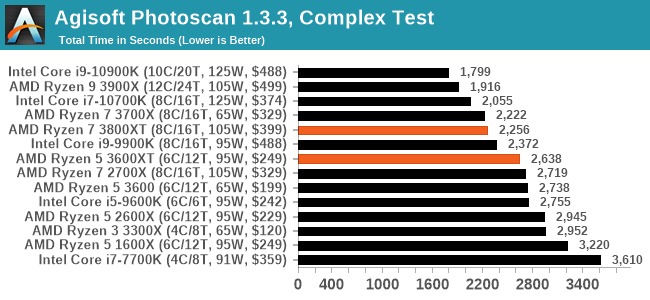
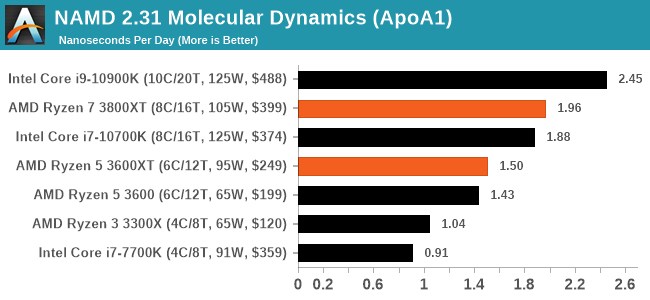

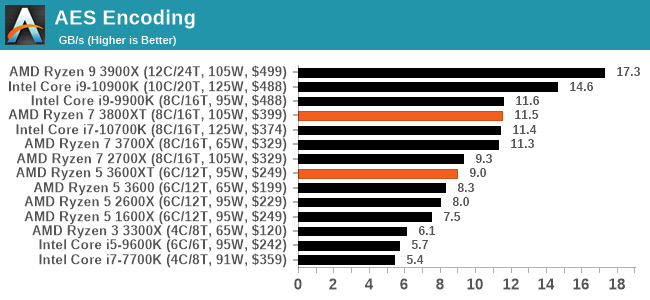
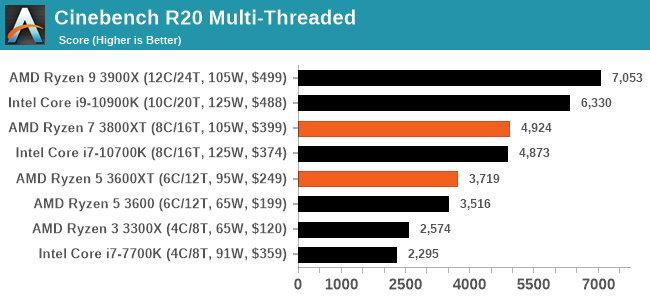
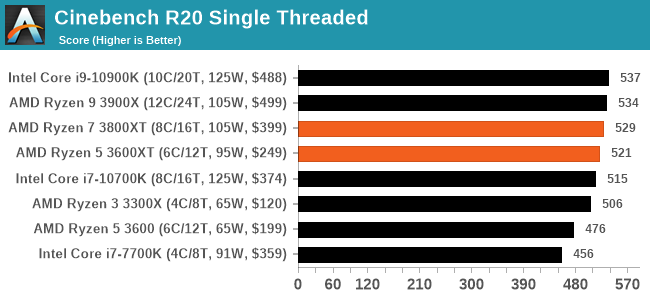
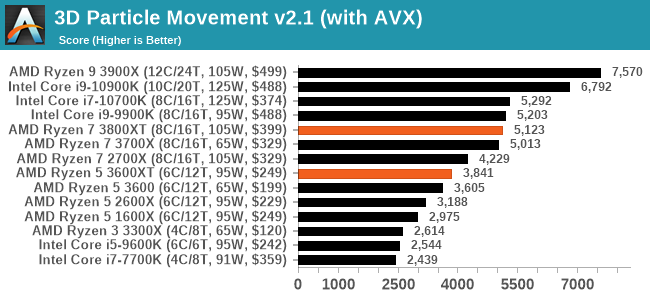
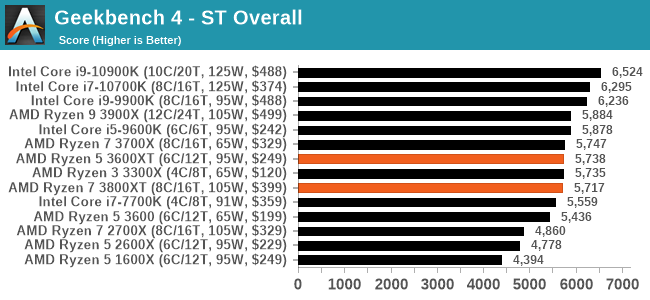
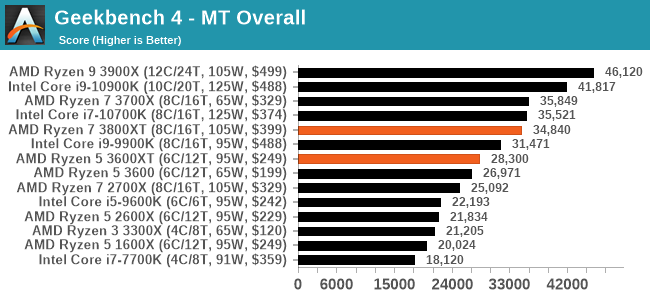
Graphs will be updated as results come in.
As we can see, there isn’t much between the old X models and the new XT models – increasing the turbo frequency a little means that there is scope for increased performance in low thread-count workloads, but ultimately the voltage/frequency curve when we start pushing with more cores loaded counts in those high density benchmarks.
We’re planning on doing a full article with our updated benchmark suite and new tests after we’ve done more regression testing. There will also be a new section in Bench to cover our new benchmark suite. Stay tuned for that.
Related Reading
- AMD To Launch New Ryzen 3000 XT CPUs: Zen 2 with More MHz
- Electromigration: Why AMD Ryzen Current Boosting Won't Kill Your CPU
- AMD Ryzen 5 3600 Review: Why Is This Amazon's Best Selling CPU?
- The AMD Ryzen 3 3300X and 3100 CPU Review: A Budget Gaming Bonanza
- AMD’s Mobile Revival: Redefining the Notebook Business with the Ryzen 9 4900HS (A Review)
- The Corsair Hydro X Custom Water Cooling Review, on a Ryzen 9 3950X
- The ASRock X570 Aqua: A $1000 Ryzen Halo Motherboard Reviewed
- The AMD Ryzen Threadripper 3960X and 3970X Review: 24 and 32 Cores on 7nm










111 Comments
View All Comments
romrunning - Tuesday, July 7, 2020 - link
I'm okay with including one or two retailers just to provide context for price comparison. Amazon/Newegg are shipping everywhere, as opposed to some of Microcenter's "in store only" deals. So use Amazon/Newegg pricing for context, and the consumer can be aware that they can always price-shop on other retail sites.The prices can be linked dynamically through back-end APIs so that it would show that day's pricing. Then the consumer would know how much roughly it would cost them today, and if they look at the article again next week, it could show the price then.
The key point for me, as a consumer, is to get the price/value comparison today if I'm going to place an order today. So if I find the 3800X is selling at $320, the 3800XT is $400, and the 10700K is at $410, then helps me determine what my best value option. Show the MSRP only doesn't give me the full picture, especially if the 3800X is listed at the original MSRP of $399.99.
haukionkannel - Wednesday, July 8, 2020 - link
I agree msrp is most usefull!For example in europe the price difference between non x, x, and Xt versiona Are much smaller. All of those Are really close to msrp prices!
I don`t mind if there is link to current street prices, but it seems that the sale of non x and x models is ower so Sooner or later the price of non x, and x models get very newar the price of Xt models Also in USA. (Until there is the next sale that can affect the Xt models too!)
But in anyway msrp is the best option, it tells what price you Are expected to pay, unless there is temporary sale somewhere that you should use to your adwantage.
Spunjji - Wednesday, July 8, 2020 - link
There's a difference between "I might be able to get this for this price" and "nobody is selling this product at MSRP", though. Of course we wouldn't be expecting Anandtech to reflect every fluctuation in price in a JPEG chart - but on the flip side of that, by using MSRP to compare a brand-new product to a product that has settled into the marketplace, they give the newcomer an unfair advantage as products are more likely to drop *below* MSRP over time than the inverse.shabby - Tuesday, July 7, 2020 - link
I agree but in a way it doesn't matter because if someone decides on the 10900K based on its performance/price and then tries to buy it they'll see that they're screwed.Spunjji - Wednesday, July 8, 2020 - link
This is a valid point. It's admittedly difficult for Anandtech to hit a moving target re: price, but the way pricing information is presented here is deeply misleading.Valantar - Tuesday, July 7, 2020 - link
No news on Renoir APUs launching today? Was really hoping for those to be announced at the same time as the XT chips ...yeeeeman - Tuesday, July 7, 2020 - link
july 21stValantar - Tuesday, July 7, 2020 - link
But that's soooooo faaaaaaar into the future :'( Two whole weeks more? Man, I was hoping to get my new HTPC built this summer ...psychobriggsy - Tuesday, July 7, 2020 - link
It's a shame that AMD didn't boost the TDP a little to match the Intel competitors (on paper, in reality it would still be way below) and then boost the base clocks a little as well.In reality this seems like an easy way to get some media column inches mid-year, and AMD wins whether it's 'XT is good' or 'XT is good but X is better value'.
yeeeeman - Tuesday, July 7, 2020 - link
they are already turbo-ing very high all core, so AMD can't do too much to improve these.